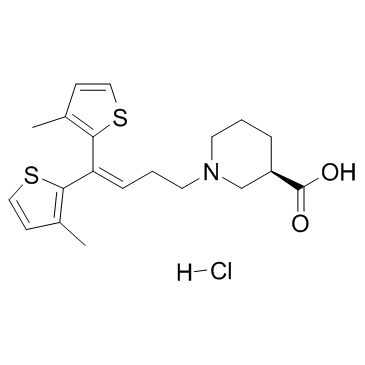Tiagabine hydrochloride

Tiagabine hydrochloride structure
|
Common Name | Tiagabine hydrochloride | ||
|---|---|---|---|---|
| CAS Number | 145821-59-6 | Molecular Weight | 412.009 | |
| Density | N/A | Boiling Point | 568ºC at 760 mmHg | |
| Molecular Formula | C20H26ClNO2S2 | Melting Point | >192oC dec. | |
| MSDS | Chinese USA | Flash Point | 297.3ºC | |
| Symbol |



GHS02, GHS06, GHS08 |
Signal Word | Danger | |
Use of Tiagabine hydrochlorideTiagabine hydrochloride(NO328 hydrochloride) is a selective gamma-aminobutyric acid (GABA) reuptake inhibitor.Target: GABA reuptake inhibitorTiagabine had an early onset of effect, as shown by significant reduction from baseline in mean HAM-A total score compared with placebo at week 1 (observed cases, p < .05). Tiagabine was generally well tolerated and not associated with changes in sexual functioning or depressive status. Symptoms of a discontinuation syndrome during taper were not observed. Tiagabine may be a useful treatment option for adult patients diagnosed with GAD [1]. Tiagabine was generally well tolerated; the most common adverse events were nausea, dizziness and headaches [2]. Tiagabine (0.1 microM), an antiepileptic drug that specifically inhibits the GAT-1 GABA transporter inhibited GABA uptake 50% in temporal cortex and 60-68% in white structures [3]. |
| Name | tiagabine hydrochloride |
|---|---|
| Synonym | More Synonyms |
| Description | Tiagabine hydrochloride(NO328 hydrochloride) is a selective gamma-aminobutyric acid (GABA) reuptake inhibitor.Target: GABA reuptake inhibitorTiagabine had an early onset of effect, as shown by significant reduction from baseline in mean HAM-A total score compared with placebo at week 1 (observed cases, p < .05). Tiagabine was generally well tolerated and not associated with changes in sexual functioning or depressive status. Symptoms of a discontinuation syndrome during taper were not observed. Tiagabine may be a useful treatment option for adult patients diagnosed with GAD [1]. Tiagabine was generally well tolerated; the most common adverse events were nausea, dizziness and headaches [2]. Tiagabine (0.1 microM), an antiepileptic drug that specifically inhibits the GAT-1 GABA transporter inhibited GABA uptake 50% in temporal cortex and 60-68% in white structures [3]. |
|---|---|
| Related Catalog | |
| References |
| Boiling Point | 568ºC at 760 mmHg |
|---|---|
| Melting Point | >192oC dec. |
| Molecular Formula | C20H26ClNO2S2 |
| Molecular Weight | 412.009 |
| Flash Point | 297.3ºC |
| Exact Mass | 411.109344 |
| PSA | 97.02000 |
| LogP | 5.78470 |
| Vapour Pressure | 9.71E-14mmHg at 25°C |
| InChIKey | YUKARLAABCGMCN-PKLMIRHRSA-N |
| SMILES | Cc1ccsc1C(=CCCN1CCCC(C(=O)O)C1)c1sccc1C.Cl |
| Storage condition | -20°C Freezer |
| Symbol |



GHS02, GHS06, GHS08 |
|---|---|
| Signal Word | Danger |
| Hazard Statements | H225-H301 + H311 + H331-H370 |
| Precautionary Statements | P210-P260-P280-P301 + P310-P311 |
| Hazard Codes | Xn |
| Risk Phrases | R20/21/22 |
| Safety Phrases | 36/37 |
| RIDADR | UN1230 - class 3 - PG 2 - Methanol, solution |
|
Behavioral and cognitive effects of anti-epileptic drugs.
Discov. Med. 9(45) , 138-44, (2010) Anti-epileptic drugs (AEDs) have a variety of mechanisms of action which are reflected through different anticonvulsant activities and behavioral effects. Two categories of AEDs are considered based o... |
|
|
A novel compound N(1),N(5)-(Z)-N(10)-(E)-tri-p-coumaroylspermidine isolated from Carthamus tinctorius L. and acting by serotonin transporter inhibition.
Eur. Neuropsychopharmacol. 19(10) , 749-58, (2009) Safflower, the dry flower of Carthamus tinctorius L., has long been applied for empirically treating cerebral ischemia and depression in traditional Chinese medicine. Pathogenesis of major depression ... |
| (-)-(R)-1-[4,4-Bis(3-methyl-2-thienyl)-3-butenyl]nipecotic acid hydrochloride |
| acide (3R)-1-[4,4-bis(3-méthylthiophén-2-yl)but-3-én-1-yl]pipéridine-3-carboxylique chlorhydrate |
| Abbott-70569.1 |
| EINECS 200-659-6 |
| (3R)-1-[4,4-Bis(3-methyl-2-thienyl)but-3-en-1-yl]piperidine-3-carboxylic acid hydrochloride (1:1) |
| (3R)-1-[4,4-Bis(3-methylthiophen-2-yl)but-3-en-1-yl]piperidin-3-carbonsäurehydrochlorid |
| 3-Piperidinecarboxylic acid, 1-[4,4-bis(3-methyl-2-thienyl)-3-buten-1-yl]-, (3R)-, hydrochloride (1:1) |
| Tiagabine hydrochloride |
| (3R)-1-(4,4-bis(3-methyl-2-thienyl)-3-butenyl)-3-piperidinecarboxylic acid hydrochloride |
| (3R)-1-[4,4-bis(3-methylthiophen-2-yl)but-3-en-1-yl]piperidine-3-carboxylic acid hydrochloride |
| (3R)-1-[4,4-bis(3-methylthiophen-2-yl)but-3-enyl]piperidine-3-carboxylic acid,hydrochloride |
| (3R)-1-[4,4-bis(3-methylthiophen-2-yl)but-3-en-1-yl]piperidine-3-carboxylic acid hydrochloride (1:1) |
| MFCD07369025 |
| (3R)-1-[4,4-Bis(3-methyl-2-thienyl)-3-buten-1-yl]-3-piperidinecarboxylic acid hydrochloride (1:1) |
| Abbott-70569.HCl |
| 3-piperidinecarboxylic acid, 1-[4,4-bis(3-methyl-2-thienyl)-3-butenyl]-, (3R)-, hydrochloride |
| Tiagabine (hydrochloride) |